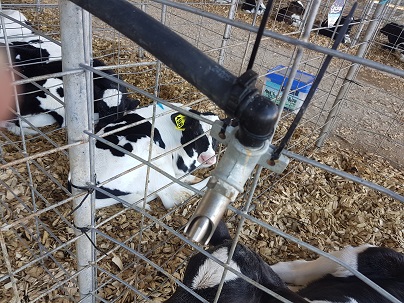Calf Water Intake is Dynamic

A 36 kg calf will lose around 3.8 lts of water from its body in urine, faeces, skin, mouth and respiratory secretions each day. 4 litres of milk intake only provides 3.5 lts of water/day. Without additional water intake over and above milk, the calf will dehydrate and most likely die from disease having easy domination over a water-stressed system.
Add to this, a sick calf with diarrhoea will drink less milk, excrete more water and usually dies of dehydration. If you are feeding electrolytes to scouring calves it is necessary they either drink milk also, or calf starter grain to maintain energy intake or starvation will finish them. Initially, until the calf is drinking from a separate water source, filling the milk feeder with warm water within 10 to 30 minutes of feeding milk will drive water intake. Water temperature does affect intake. Research has demonstrated a 50% increase in water intake when close to body temperature.
There is a direct correlation between water intake and calf grain intake. Research has suggested between 4:1 & 6:1 ratio of water to grain intake. Taking an average of 5:1, our calf must drink 5 litres of water to consume 1 kg of calf grain. A good calf grain mix should supply more energy and protein than milk. Obviously, the faster we have calves increasing water intake, the more grain they will eat and their plain of nutrition (energy & protein) will rise rapidly. Accordingly, growth rate will also accelerate rapidly. By day 56 this ratio is closer to 2:1 through rumen development.
Calf grain intake plays another major role apart from simply increasing energy and protein intake. A course grain mix (as opposed to pelleted) will help increase water intake, but apart from that, starch from grain will produce Volatile Fatty Acids from grain digestion which drives the growth of rumen papillae, the absorption site of nutrient to the blood stream. The faster we develop rumen papillae the sooner the calf can be weaned as it will be capable of digestion solid foods then. We use calf grain intake as the indicator for weaning. A calf consuming 2 kgs of calf grain daily has developed the rumen sufficiently to digest solid feeds and can be weaned. There is a significant cost saving in both feed cost and labour to benefit from by early weaning.
Grain intake must continue to rise post-weaning as the rumen, although developed sufficiently to extract nutrient from grain mixes, it still cannot digest forage adequately to supply the necessary energy and protein for both maintenance and growth. Calves are unable to digest forage well before six months of age. Water intake remains the driver of post-weaning growth by its ratio of 2:1, water to grain, increasing the calf’s rising plane of nutrition correlating growth and development. Water quality also plays a major role in calf growth due to its relation to grain intake.